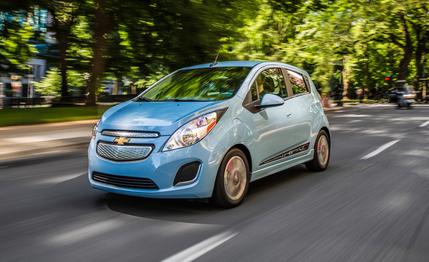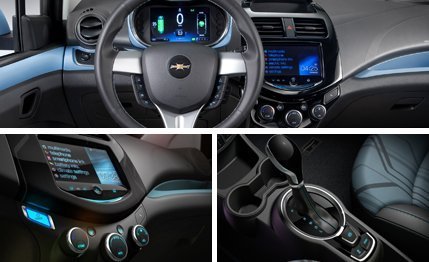 First Drive Review
First Drive Review
The traffic signal at the top of a steep grade turned yellow as we approached in a Chevy Spark EV. In a gasoline-powered Spark, we'd have to stomp the brakes, but instead we chose the accelerator, scooting through with ease. So much for “glorified golf cart” prejudices.
GM builds its own oil-cooled permanent-magnet electric motor for this Spark at a plant in Baltimore, a motor it promises will appear in another, as yet unnamed, product in the pipeline. Take note: One day it could be remembered as the small-block of the electric segment.
Instant Electric Torque, and Lots of It
It spins out 105 kW (140 horsepower) and a strong 400 lb-ft of torque. That latter figure, especially, makes us think it's past time the Society of Automotive Engineers (SAE) weighed in with a standard for reliable comparisons, but once you drive it, there's no question this motor's got muscle. Car and Driver estimates the Spark EV can reach 60 mph in fewer than eight seconds (versus 11-plus for the gas model). We’ll update that number once we’re able to test one with our gear.
On paper, the Spark EV and its 21-kWh lithium-ion battery pack most resemble the Honda Fit EV, with enough additional power to shave most of a second off the Honda’s 0-to-60 time. Although we found electrification dulls one of our favorite Hondas, the reverse seems true of the Chevy: It makes a boring car intriguing.

Just Put It on My Charge
The car’s stated range is 82 miles. GM promises a DC fast-charge option coming this fall. It’s essentially an SAE standard established as the industry’s answer to Tesla’s Supercharger, as backed by GM, BMW, Ford, Chrysler/Fiat, Daimler, and the Volkswagen Group. The $750 option covers a dedicated plug and electronic control box to hook up with chargers that can deliver a 100-percent charge in 20 minutes and 50 percent in 12. Otherwise, it's seven hours at 240 volts or 20 at 110.
It's not only thrust that makes this Spark more interesting. The power transplant is at least partly offset by a not-insignificant 600-pound gain in curb weight, but the extra pounds all sit low in the chassis and more to the rear. The battery pack straddles the rear axle, under the cargo bay and rear seat with no reduction in interior or cargo volume. The center of gravity is more than two inches lower and the front-rear weight distribution close to 50/50. Electric Sparks get four-wheel disc brakes (versus the gas model's disc-and-drum setup), and their rear tires are wider than the fronts (195/65-15 versus 185/65-15). Recalibrated springs, dampers, and suspension components strive to make good on Chevy's promise that the Spark EV is “fun to drive,” and they mostly succeed—the handling felt pleasantly balanced and responsive on Portland's curving parkway roads, the steering a little sharper than in the gas model, if still lacking in feel. Grip might be a concern. Our road test of the gas Spark returned a mediocre 0.79 g on the skidpad, and it's hard to imagine the low-rolling-resistance Bridgestone rubber on the EV will improve matters. Use the car's power freely, and the Spark EV seems to rely on electronic traction control more than mechanical grip.